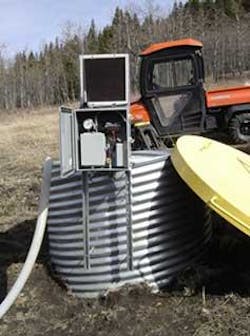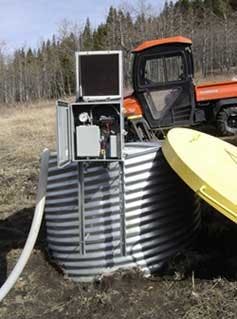Monitoring System Saves Pipe from Severely Corrosive Environment
by Elfriede Lynch-Willson
• Corrosion monitoring system from Enviroline alerts a Canadian oil & gas pipeline operator of a problem, allowing it ample time to fix it before destructive wall loss could occur.
After pigging one of its gathering lines as part of its regular maintenance, a majoroil & gas pipeline company in Western Canada became concerned about wall loss in one section due to corrosion. Though not immediately in jeopardy of rupturing, the company understood it needed to replace the section of pipe. To keep the pipeline operational until the section could be replaced, the company installed two Field Signature Method (FSM) units and an Enviroline Hydrogen Monitoring System to the section of pipe, to monitor for additional corrosion and wall loss.
Initially, the pipeline remained stable, each unit reported no additional corrosion or wall loss. The company was confident its inhibitor process was protecting the pipe from further deterioration.
In August of 2007, however, the Enviroline monitor readings began to fluctuate, though the two FSM units reported no changes. The company hadn't made any changes to its inhibitor process and didn't feel the corrosive environment inside the pipe had worsened, so it contacted Enviroline believing the Enviroline monitor was malfunctioning.
Enviroline visited the site to check the system but found nothing wrong with its unit. After several weeks, the readings from its monitor indicated a gradual increase in corrosive activity, yet the two FSM units still showed no change.
To understand what was happening inside the pipe, the pipeline operator performed additional testing and reviewed previous process data. The company discovered a highly corrosive environment may have resulted from acidization (chemical flooding) of an upstream well in June that releases 18 times the normal amount of water into the pipeline. This water produced a highly corrosive environment, yet several unusual circumstances prevented the pipeline company from realizing the change until two months later, when the Enviroline system first alerted them. As a result of its findings, the pipeline operator pigged the line and increased the inhibitor rate to stabilize the environment. After testing for additional wall loss, it was pleased to report no significant deterioration in the pipe, thanks to the early notification.
The monitoring system is based on the principle of hydrogen flux — as corrosion occurs and metal dissolves on the inside of a tank or pipe, atomic hydrogen is formed and, because of its small size, permeates through the metal wall. Such movement of hydrogen atoms through a tank or pipe is often the first sign a corrosive environment exists. Additionally, hydrogen in the metal wall can cause hydrogen embritlement, hydrogen induced cranking (HIC), hydrogen blistering, and stress corrosion cracking (SCC), all potentially devastating conditions for a tank or pipe.
The Enviroline system utilizes this natural process of hydrogen flux to monitor for corrosion. A vacuum is placed outside the tank or pipe that collects escaping hydrogen molecules. This data is sent continuously via satellite to the company's website where it's charted to provide a visual representation of the migration and corrosion activity. Pipe and tank operators have instant, accurate access via web reporting and email alerts of corrosive conditions inside their tank or pipe.
This major oil & gas pipeline company expects to add many more Hydrogen Corrosion Monitors to its pipeline network as a result of the fast and accurate performance of the Enviroline system.
About the Author: Elfriede Lynch-Willson is Enviroline Monitoring Systems marketing manager at Enviroline Group. The Pompano Beach, FL-based industrial environmental linings and coatings specialist is the manufacturer of the Hydrogen Corrosion Monitor, the only continuous system used for both corrosion and process monitoring. Contact: 800-449-6525, [email protected] and www.envirolinegroup.com/ems/
